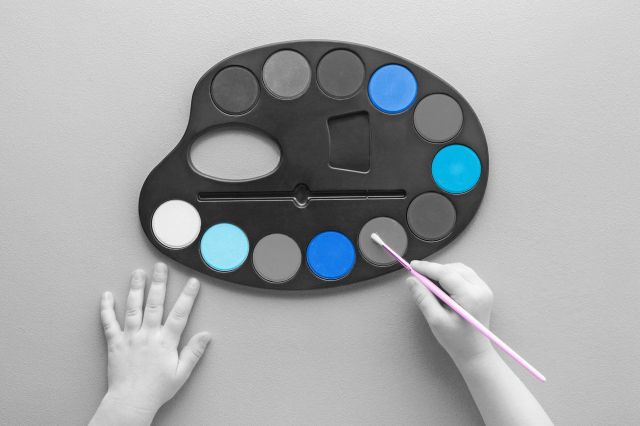
Your Favorite Color Is Blue (Probably)
Since the first color surveys in the 1800s, blue has been our species’ favorite color overall — and the trend is truly global. One YouGov study from 2015 surveyed 10 countries across four continents, and found that blue reigned supreme in all of them, scoring 8 to 18 percentage points higher than the second-place color. In the U.S., 32% of respondents preferred blue, with men consistently favoring the color (40%) compared to women (24%). Green scored the silver medal, and purple nabbed the bronze. Scientists who study color theorize that this widespread love of blue is likely because it’s often tied to positive experiences, such as Earth’s bright blue skies and oceans. Oh, and humanity’s least favorite color? Dark yellowish brown.

The Sky Is Blue Because of the Color’s Wavelength
The sun sends its rays to Earth as white light, meaning they contain everything in the color spectrum (red, orange, yellow, green, blue, indigo, violet). But blue is unlike the other colors, because its specific wavelength (between 450 and 495 nanometers) is more frequently scattered by particles in the atmosphere in a process known as Rayleigh scattering. At midday, the sky is pale blue as the sun’s light travels through less of the atmosphere, but as the sun heads toward the horizon, the sky becomes a richer blue because light travels through more of the atmosphere (thus scattering more blue light).
However, this is only half of the answer, because indigo and violet have even shorter wavelengths than blue, which raises the question: Why isn’t the sky violet? Figuring out this conundrum means taking a closer look at the human eye. The cones inside the eye are coded to perceive red, green, and blue (what’s known as trichromatic vision) and it’s the combinations of these inputs that determine variations of color. Because of the eye’s sensitivity to the color blue, the sky takes on that particular hue instead of violet. Other animals likely perceive the sky (and the rest of the world) in a different hue because most mammals are actually dichromatic, meaning they only have two different types of cones.

Blue Eyes Aren’t Actually Blue
Between 6,000 and 10,000 years ago, all humans had brown eyes, until a single genetic mutation caused one human to be born without the usual brown-black melanin pigment that colors irises brown. Irises without this pigment experience what’s known as the Tyndall effect (yes, the same reason why the sky is blue). Because of blue’s short wavelength, that spectrum of light is reflected most by the fibers in the iris, causing eyes to take on a bluish color even though there is no blue pigment present at all. Today about 10% of the world’s population has blue eyes, though that number is skewed heavily by northern Europeans. In Finland and Estonia, for example, 89% of people have blue eyes — the highest percentage in the world. The U.S. comes in much lower at around 27%.
More Interesting Reads

Lapis Lazuli Was a Blue Gem Prized by Many Ancient Civilizations
Many ancient civilizations in Mesopotamia, Egypt, China, Greece, Rome, and India prized a blue gem known as lapis lazuli. The gem appears in the myths of the Sumerians as far back as 4000 BCE, and in ancient Egypt, pharaohs wore the precious stones in pieces of ostentatious jewelry (likely bedecked with other blue gemstones such as sapphire and turquoise).
Lapis lazuli was largely mined in present-day northeastern Afghanistan starting as early as the seventh millennium BCE. The stone appears in some of the world’s earliest civilizations, including the Indus Valley Civilization in India and Pakistan. Lapis lazuli continued playing a role in human culture for thousands of years, even up to the Renaissance, as painters often ground the gem to produce the highly sought-after pigment ultramarine. The pigment was so expensive, even legendary painters such as Michelangelo couldn’t afford it.

There’s a City in Morocco That’s Painted Blue
Chefchaouen is a city nestled in the Rif Mountains of northwestern Morocco. With one of the country’s most popular medinas outside of Marrakech, the city is already on the map for many tourists, but Chefchaouen is also known by another famous moniker — “the Blue Pearl.” That’s because a large portion of the city has been painted various shades of blue.
There is no official story as to why the city is plastered with blue hues, though there are many local legends. Some say the blue color keeps buildings cool, others say it deters mosquitoes, while others still say the blue color honors the importance of the nearby Ras el-Maa Waterfall. However, the leading theory dates back to the 15th century, when Chefchaouen served as a refugee camp for Jews and Muslims fleeing persecution by the Spanish Inquisition. Per Jewish tradition, these refugees painted their homes blue (an important color in Judaism) as a reminder of God’s power. Although the Jewish population has since largely left the area, the Muslim-majority city continued the tradition, and the Blue Pearl continues to shine centuries later.

Your Blue Veins Are Actually an Illusion
Look at your arm, and you’ll see blue veins crisscrossing just beneath the skin. That’s an optical illusion. Human veins are not blue, and are actually transparent. While deoxygenated blood is a darker hue of red (which you’ve likely seen if you’ve ever donated blood or had blood drawn), the blue color comes from your skin scattering light, so that we perceive the veins beneath the skin as blue. The color perception of veins can also change depending on skin tone, as darker skin will turn veins more of a greenish color. While blue blood doesn’t occur naturally in humans, it is found in animals such as the horseshoe crab (whose blue blood has actually saved countless human lives). This family of crab sports blue blood because it contains copper pigments instead of iron.











